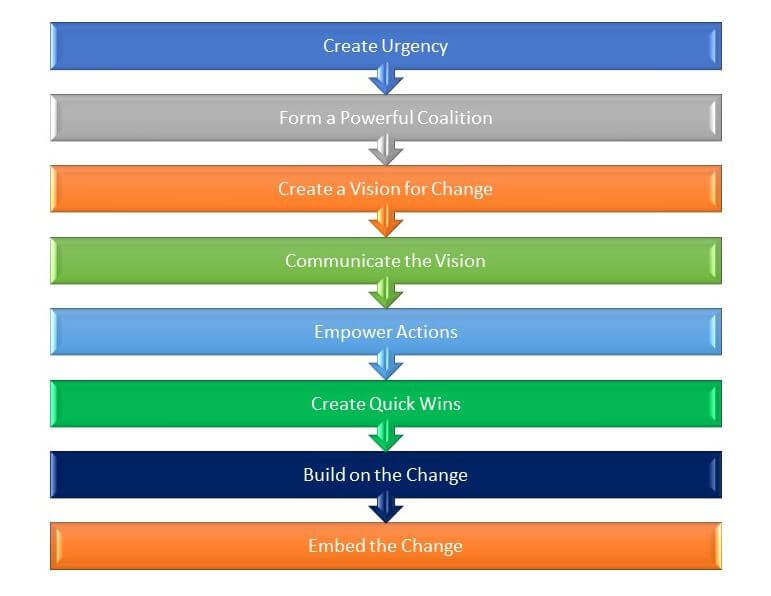What is Kotter’s 8-Step Change Model?
Kotter’s 8-Step Change Model is a theory that suggests there are specific steps that need to be followed in order to implement change in an organization.
The Model offers a systematic way of understanding the underlying causes of successful or unsuccessful change initiatives. This model uses concepts and techniques that help to provide guidance on the process of change. It has been used by organisations to successfully implement changes such as restructurings and mergers.
In his book “Leading Change,” John Kotter (1996), a Harvard Business School professor and noted change specialist, proposed the 8-Step Model of Change, which he created based on research of 100 businesses in the midst of a change process. Creating a sense of urgency, forming powerful guiding coalitions, developing a vision and strategy, communicating the vision, removing obstacles and empowering employees to take action, achieving short-term wins, consolidating gains, and strengthening change by anchoring change in the culture are the eight steps in the change process.
8 Steps of Kotter’s Change Model

1) Creating Urgency
Creating a sense of urgency regarding the need for change is the first step. It is essential to communicate the reasons why change is necessary and the dangers of not changing. This can be accomplished through the use of data, anecdotes, or other persuasive messages that motivate individuals to take action.
This can be accomplished in a variety of ways:
- Identifying and emphasising possible risks and consequences that may arise in the future.
- Investigate the possibilities that can be realised through effective interventions.
- Initiate open and honest discussions and debates to encourage others to consider the problems at hand and to provide persuasive arguments for doing so.
- On the topic of change, we request the participation and assistance of industry professionals, important stakeholders, and customers.
2) Form a Powerful Coalition
After establishing a sense of urgency, it is essential to form a coalition of influential individuals who can support the change initiative. This coalition should include individuals with the knowledge and authority to implement change from across the organization. This step involves identifying key stakeholders and assembling a committed team for the change initiative.
This can be accomplished in a variety of ways:
- Identify your organization’s successful change leaders as well as important stakeholders and seek their participation and commitment to the whole process.
- Form a strong change alliance that will work together.
- Identify the weak points in the coalition teams and make sure that they include a diverse group of important people from various cross-functional departments and levels of the organization.
3) Create a Vision for Change
The third stage entails articulating a distinct and compelling vision for the change. This vision should be conveyed to all participants in the change initiative and should be simple to comprehend and recall. The vision should be consistent with the organization’s values and objectives, as well as inspiring enough to motivate people to take action.
This may be accomplished by using the following methods:
- Identifying fundamental principles, establishing the ultimate vision, and developing methods for implementing change in a company.
- Ascertain that the change leaders can successfully explain the vision in a way that people can comprehend and follow.
4) Communicate the Vision
Once the vision has been established, it is crucial to effectively communicate it to everyone involved in the change initiative. This involves utilizing multiple channels and formats to reach diverse audiences and ensure that everyone understands their role in accomplishing the vision. Throughout the transformation process, communication should be ongoing.
Also Read: What is the ADKAR Change Management Model?
5) Empower Actions
- Ascertain that the organization’s procedures and structure are in place and that they are in line with the company’s overarching goal.
- Check for obstacles or persons who are resistant to change on a regular basis. Take proactive steps to overcome the challenges that come with the transition process.
- Incentivize employees for embracing change and assisting in the transition.
6) Create Quick Wins
The sixth phase is to create short-term wins that demonstrate progress toward the vision. These victories should be visible and measurable, and they should be celebrated to generate momentum and support for the change initiative.
7) Build on the Change
After achieving short-term success, it is essential to consolidate the gains and use them as a basis for further change. This involves building on past successes and implementing the necessary changes to realize the vision.
8) Embed the Change
The final stage involves integrating the new approaches and changes into the culture of the organization. This entails ensuring that the changes are ingrained in the organization’s processes, policies, and practices and are maintained over time. This phase is essential for ensuring that the modifications become a permanent part of the organization’s practices.
Advantages of Using Kotter’s Change Model
Some advantages of using Kotter’s 8-Step Change Model are:
- As a step-by-step model, it gives a clear definition of the whole change process and provides direction on how to apply it.
- It guides the decision-makers on the road to success.
- To start a change programme, the decision-makers need to have a clear and concise picture of the possible success of the change.
- The effectiveness of the whole process depends on the employees’ engagement and acceptance.
- Instead of focusing on the actual change process, the focus is on preparing and developing acceptability for it.
What is the difference between Lewin’s model and Kotter’s model?
Three stages make Lewin’s model appear to be easy. Unfreeze, Transition, and Freeze are the terms used to describe them. Try to reduce the forces involved in keeping things as they are. Keeping things as they are might be viewed as the equilibrium stance. It is possible to unfreeze by, for example, strengthening the pressures that push behaviour and attitudes away from the status quo. Organizational reforms or new development approaches can accomplish this.
Kotter’s approach is more useful since it gives defined phases for the transformation process. But because of its rigidity, stages cannot be omitted and the process might take a while to complete.
Insights into successful change management may be gained from both approaches. As long as both are utilized in combination, the inherent weaknesses of either one may be mitigated to some extent.
This is exemplified by the training firm Velopi, for instance. They used Kotter’s model to fill out Lewin’s stages in greater depth. In terms of change management, you may either take a strict strategy with numerous phases, or you can simplify your approach. In the first example, Kotter’s model is more appropriate, whereas, in the second, Lewin’s model is preferable.
Learn more about Lewin’s Model



